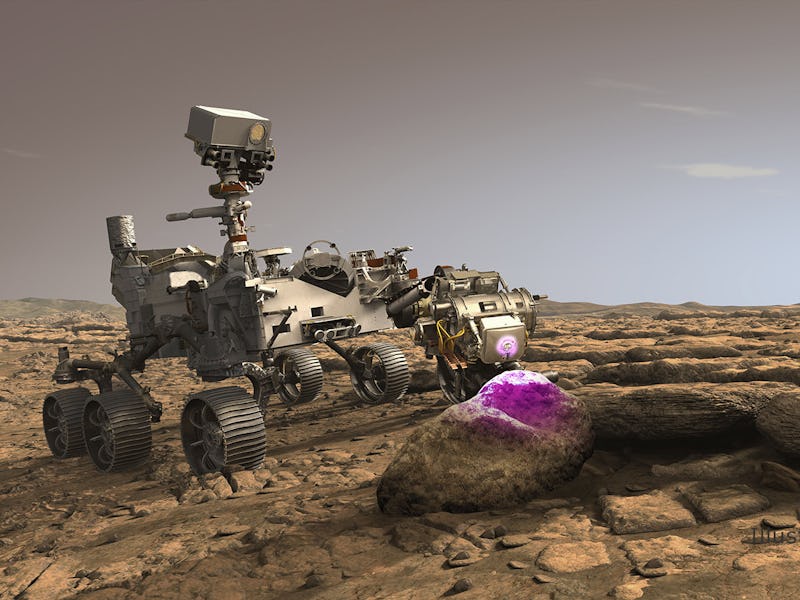NASA's Perseverance rover will use X-rays to find ancient life on Mars
The robot will scan Martian rocks using an X-ray beam.

NASA's Perseverance rover is currently on its 40 million mile journey through space, and is expected to land on Mars by February, 2021. Once it does, the robotic explorer will hunt for clues of ancient microbial life on the Martian landscape.
In order to scan the rocks on Mars for the tiniest hints of life that existed billions of years ago, Perseverance will use a precision X-ray device powered by artificial intelligence dubbed as PIXL.
READ MORE PERSEVERANCE ROVER NEWS FROM INVERSE
The rover will collect at least 20 samples from Mars using a handy drill, literally attached to the robot's arm. The rock samples will be stored away in tubes in a well-identified place on the Martian surface, and left there to be returned to Earth by a future sample return mission to the Red Planet.
But first, Perseverance will use PIXL to scan the rocks using the powerful X-ray beam in order to see where and how much the chemicals are distributed across the rocks' surface.
PIXL takes pictures of the rock samples before scanning them for their chemical composition.
"PIXL's X-ray beam is so narrow that it can pinpoint features as small as a grain of salt. That allows us to very accurately tie chemicals we detect to specific textures in a rock," Abigail Allwood, PIXL's principal investigator at NASA's Jet Propulsion Laboratory in Southern California, said in a statement.
Once it has scanned the rocks, the results from PIXL will inform the science team behind Perseverance over which rocks show potential for housing ancient microbial life and are therefore worth returning to Earth for further investigation.
PIXL, short for Planetary Instrument for X-ray Lithochemistry, is about the size of a lunchbox and located at the end of Perseverance's 7-foot long robotic arm.
The device measures X-rays in 10-second bursts from a single point on a rock and then tilts 100 microns before taking another measurement. It may need to continue to do this for eight or nine hours straight, taking thousands of measurements in order to map the chemicals found within a small area about the same size as a postage stamp, according to NASA.
PIXL is connected to the robot's arm using a hexapod, a device with six mechanical arms that sort of looks like a robot spider. Using artificial intelligence, the hexapod is guided by the machine to get the most accurate aim of the rocks before PIXL begins to scan them.
The hexapod sits at the end of Perseverance's arm, helping the robot take accurate scans of the Martian rocks.
Once Perseverance's robotic arm is placed close to an interesting rock, PIXL will use a camera and laser to calculate the distance. Then the hexapod's six legs make small movements, the distance of just about 100 microns or about twice the width of a human hair, so the device can scan the target.
"The hexapod figures out on its own how to point and extend its legs even closer to a rock target," Allwood said. "It's kind of like a little robot who has made itself at home on the end of the rover's arm."
PIXL only works at night, operating after the Sun sets on Mars in order to avoid being affected by the metal on Perseverance's arm expanding and contracting due to the difference in temperatures on Mars from day to night.
"PIXL is a night owl," Allwood said. "The temperature is more stable at night, and that also lets us work at a time when there's less activity on the rover."
The Perseverance rover launched on July 30 from the Space Launch Complex 41 at Cape Canaveral Air Force Station.
The robot will land on the Jezero Crater, a 28-mile wide, 500-meter-deep crater located in a basin slightly north of the Martian equator.
Once it lands on Mars, Perseverance will begin hunting for clues of past microbial life that may have existed during the Red Planet's early history. The mission will also test out conditions for possible human exploration of Mars by trialing a method of producing oxygen from the Martian atmosphere, characterizing environmental conditions such as water and dust on Mars, and looking for resources.